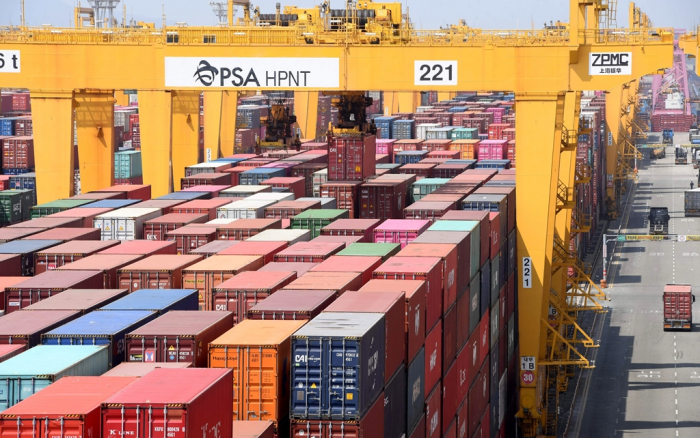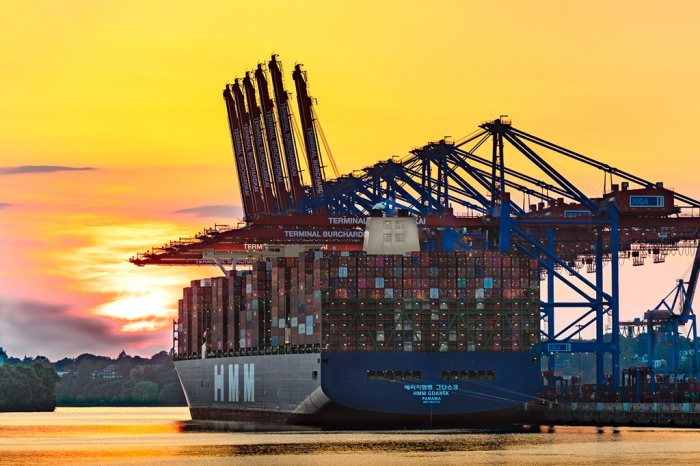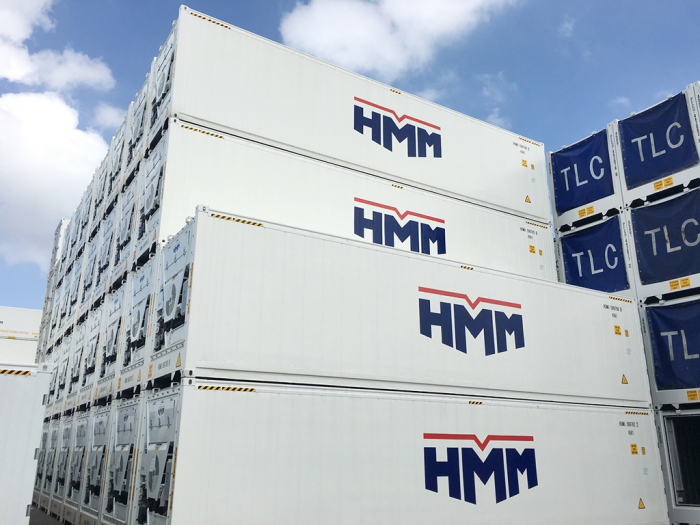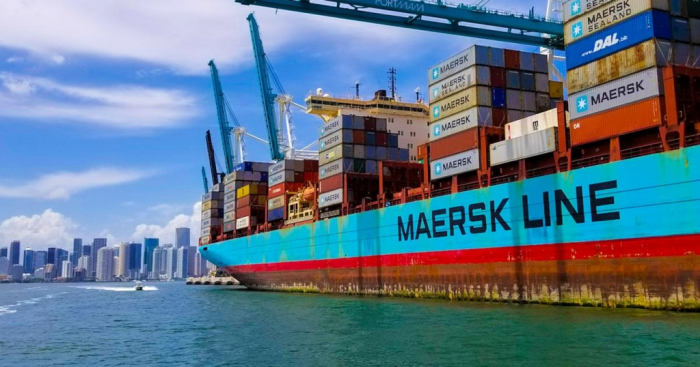Markets
HMM shares weighed by overhang concerns despite soaring profit
The stock is 'deeply undervalued' with its price-earnings ratio of 1.96, far below the industry’s average multiple of 20
By Mar 24, 2022 (Gmt+09:00)
4
Min read
Most Read
LG Chem to sell water filter business to Glenwood PE for $692 million


Kyobo Life poised to buy Japan’s SBI Group-owned savings bank


KT&G eyes overseas M&A after rejecting activist fund's offer


StockX in merger talks with Naver’s online reseller Kream


Mirae Asset to be named Korea Post’s core real estate fund operator



South Korea’s largest container line HMM Co. has seen its shares trapped in a boxed range over the past few months despite its spectacular earnings growth.
Analysts largely agree that the company’s business outlook is even brighter, with some brokerages forecasting that its full-year operating profit will surge to an all-time high of over 10 trillion won ($8.2 billion).
Nevertheless, its shares remain subdued, or “deeply undervalued” as some analysts put it, due largely to risks related to the privatization of the currently state-owned company and share overhang concerns.
According to brokerage firms on Thursday, the market consensus for HMM’s 2022 operating profit was 8.78 trillion won earlier this month. Following the Russian attack on Ukraine, however, analysts are raising their projections, citing the possibility of protracted supply chain disruptions and ensuing rises in shipping freight rates.
Daishin Securities on Wednesday revised up its forecasts for HMM’s operating profit for this year to 10.7 trillion won, much higher than the shipping line’s record profit last year of 7.38 trillion won.
HMM said in February it returned to an annual profit for the first time in a decade in 2021, boosted by higher freight rates and increased cargo volumes as the global economy is recovering from the pandemic.
Its cash and cash equivalents stood at 1.72 trillion won at the end of 2021, nearly triple that of three years earlier.

The company is widely expected to have another strong year in 2022 given the continued transport bottleneck amid a shortage of container ships.
In January alone, the company is estimated to have earned over 1 trillion won, with its first-quarter profit forecast to reach 2.5 trillion won.
RISING SHIPPING CAPACITY
With the resumption of business activities, global shipping costs soared, sending the Shanghai Containerized Freight Index (SCFI) to an all-time high of 5,109.6 earlier this year.
As of March 18, the index slipped to 4,540.31, but industry officials expect the index to head higher, driven by the Russia-Ukraine war as well as the lockdown of cities in China, including Shenzhen, due to the resurgence of the COVID-19 pandemic.
Shenzhen owns China’s third-largest port with monthly cargo traffic amounting to 2.4 million twenty-foot equivalent units or TEUs.
Analysts said HMM will be a key beneficiary as the industry continues to suffer from the lack of container ships, further fueling freight rate charges.
According to shipping industry researcher Alphaliner, HMM’s shipping capacity stood at 818,328 TEUs as of mid-March, up 97.4% from 414,600 TEUs in March 2020.
Its capacity growth outpaced that of its bigger rivals. French container shipping company CMA CGM’s capacity grew 24.3% over the same period, followed by Taiwan’s Evergreen Marine Corp.’s 22.3% and Swiss-based MSC’s 13.1%.
HMM, which currently owns 12 container ships with the 24,000 TEU size, is set to receive additional 12 units of 13,000 TEU vessels by the first half of 2024, raising its shipping capacity to 1 million TEUs.

GEAR UP FOR MASSIVE STAKE SALE
HMM’s stellar earnings growth comes as state-run Korea Development Bank (KDB), its largest shareholder and top creditor, is exploring a sale of its stake in the container ship carrier to recover taxpayers’ money it injected into the company.
HMM, formerly known as Hyundai Merchant Marine, was taken over by KDB in 2016 after the company accumulated huge losses amid an industry slowdown.
In July of 2021, the state-run bank said it is seeking to sell 2.6 trillion won in perpetual convertible bonds issued by HMM to lay the groundwork for the privatization of the company. HMM issued over 3 trillion won in bonds in 2017 to raise operating funds, and the state-run bank assumed most of them.
KDB currently owns 20.7% of HMM as its largest shareholder, followed by state-run Korea Ocean Business Corp. (KOBC), which holds a 20% stake.
In October, KOBC said it is converting its holdings of HMM’s unsecured convertible bonds into common shares.

If both KDB and KOBC convert their CBs into shares, the two largest shareholders’ combined stake in HMM will reach up to 80%. With that stake size, it’s almost impossible to privatize the shipper by selling to a single investor, analysts said.
To ease the financial burden of a potential buyer, KDB Chairman Lee Dong-gull once said it wants to sell its stake to the market in a gradual way, which in turn could create share overhang concerns.
Shares of HMM rose to a high of 51,100 won in May last year, a threefold increase from the start of 2021. But the stock has shed 39% since then to close at 31,150 won on Thursday.
“The stock is staging a rebound on expectations of a further rise in freight rates. But given its earnings growth prospects, the stock is still deeply undervalued,” said a market analyst.
The company’s price-earnings ratio (PER) is 1.96, far below the industry’s average multiple of 20 as of the end of 2021.
Write to Jeong-Min Nam at peux@hankyung.com
In-Soo Nam edited this article.
More to Read
-
 War in UkraineRussia-Ukraine war disrupts Korean exports to Europe
War in UkraineRussia-Ukraine war disrupts Korean exports to EuropeMar 07, 2022 (Gmt+09:00)
5 Min read -
 EarningsHMM returns to annual profit in a decade as stake sale looms
EarningsHMM returns to annual profit in a decade as stake sale loomsFeb 14, 2022 (Gmt+09:00)
3 Min read -
 MarketsHMM’s stock loses ground on slowing profit growth, overhang woes
MarketsHMM’s stock loses ground on slowing profit growth, overhang woesOct 28, 2021 (Gmt+09:00)
4 Min read -
 Mergers & AcquisitionsKDB seeks to sell $2.3 bn CBs in HMM to lay groundwork for stake sale
Mergers & AcquisitionsKDB seeks to sell $2.3 bn CBs in HMM to lay groundwork for stake saleJul 19, 2021 (Gmt+09:00)
3 Min read
Comment 0
LOG IN


